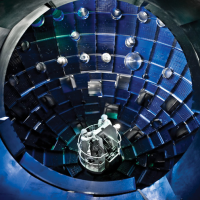Feinstein Backs off Support for Lawrence Livermore Work on Fusion
 The target chamber of the National Ignition Facility (photo: Lawrence Livermore National Laboratory)
The target chamber of the National Ignition Facility (photo: Lawrence Livermore National Laboratory)
Senator Dianne Feinstein (D-California) has thrown in the towel on trying to find the Holy Grail of energy research, hydrogen fusion, at California’s Lawrence Livermore National Laboratory.
The senator rejected an appeal from laboratory scientists and 26 members of the House of Representatives to help restore $110 million in budget cuts proposed by the Obama administration that might be critical in saving the $3.5 billion project from shutting down, according to a report in the San Francisco Chronicle.
Feinstein, who is a member of the Senate Appropriations Committee, said the scientists failed to achieve their stated goals and it was time to assess whether a new direction was needed. She appeared unhappy with a lack of responsiveness by project leaders to her inquiries of late. “I asked for new milestones and program goals more than six months ago and still have not received them,” she said.
The senator also chairs the committee’s important subcommittee on energy and water development.
Fusion research attempts to duplicate the process naturally occurring in the sun and other stars in which hydrogen atoms are fused together to produce more energy than it takes to produce the fusion.
Dozens of experiments at the lab’s National Ignition Facility (NIF) over the past three years failed to achieve the “ignition” scientists sought. They fired 192 laser beams at a single pellet of hydrogen isotopes, hoping to produce enough heat and pressure to do the deed.
Fusion holds the promise of unlimited energy produced by reactors fueled, essentially, by hydrogen in the ocean’s waters. Nuclear power is currently achieved through fission, the splitting on an atom.
Feinstein has been a longtime supporter of fusion research, making a spirited pitch (pdf) in 2001 to fund this “clean, safe, and abundant energy source for our nation's long-term energy supply.” She has also supported U.S. efforts to develop the technology even as the country has thrown its support, and money, behind international projects.
A bipartisan group of senators recently questioned the feasibility of one of those projects, the International Thermonuclear Experimental Reactor (ITER). The United States contributed $105 million to the project in fiscal year 2012 and the Obama administration requested that the amount be doubled for the coming year. The European Union covers 45.5% of the project’s funding and 9.1% is paid for by the U.S., Japan, India, China, Russia and South Korea.
While NIF has so far failed to ignite a fusion reaction, it has successfully gone where no scientists at Lawrence Livermore have gone before. Last year, the facility was used to film scenes for the movie “Star Trek: Into the Darkness.”
The movie, like the fusion project, has received mixed reviews.
–Ken Broder
To Learn More:
Feinstein Declines to Halt NIF Budget Cuts (by David Perlman, San Francisco Chronicle)
Laser Fusion’s Brightest Hope (by Rachel Courtland, IEEE Spectrum)
Bipartisan Senators Call on GAO to Evaluate Fusion Energy Experiment’s Cost Feasibility (by Sonal Patel, PowerNews)
World’s Most Powerful Laser Powers Up (by Noel Brinkerhoff, AllGov)
- Top Stories
- Controversies
- Where is the Money Going?
- California and the Nation
- Appointments and Resignations
- Unusual News
- Latest News
- California Forbids U.S. Immigration Agents from Pretending to be Police
- California Lawmakers Urged to Strip “Self-Dealing” Tax Board of Its Duties
- Big Oil’s Grip on California
- Santa Cruz Police See Homeland Security Betrayal in Use of Gang Roundup as Cover for Immigration Raid
- Oil Companies Face Deadline to Stop Polluting California Groundwater





